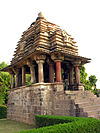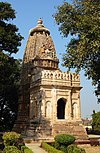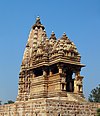Khajuraho Monuments and temples
The Khajuraho Group of Monuments is a group of Hindu, Buddhist and Jain temples in Madhya Pradesh, India.
They are one of the UNESCO World Heritage Sites in India.
Khajuraho is known for its ornate temples that are the spectacular piece of human imagination, artistic creativity, magnificent architectural work and their erotic sculptures.
The 10th-century Bhand Deva Temple near (Ramgarh crater) in Rajasthan was built in the style of the Khajuraho monuments and is often referred to as 'Little Khajuraho'.
Mahatma Gandhi wanted it buried under earth so nobody could be tempted by the beautiful statues. We are grateful to Rabindranath Tagore who prevented Gandhi from doing such a thing. He said, “Leave the temples as they are..”
Chronicled records :-
The first recorded mention of the Khajuraho temples is in the accounts of Abu Rihan al Biruni in AD 1022 and the Arab traveler Ibn Battuta in AD 1335. Local tradition lists 85 temples in Khajuraho out of which only 25 temples are surviving after various stages of preservation and care.
Most Khajuraho temples were built between 950 and 1050 by the Chandela Rajput dynasty reigns of the Hindu kings Yashovarman(925-950 CE) and Dhanga (950-999 CE).
They are one of the UNESCO World Heritage Sites in India.
Khajuraho is known for its ornate temples that are the spectacular piece of human imagination, artistic creativity, magnificent architectural work and their erotic sculptures.
The 10th-century Bhand Deva Temple near (Ramgarh crater) in Rajasthan was built in the style of the Khajuraho monuments and is often referred to as 'Little Khajuraho'.
Mahatma Gandhi wanted it buried under earth so nobody could be tempted by the beautiful statues. We are grateful to Rabindranath Tagore who prevented Gandhi from doing such a thing. He said, “Leave the temples as they are..”
Chronicled records :-
The first recorded mention of the Khajuraho temples is in the accounts of Abu Rihan al Biruni in AD 1022 and the Arab traveler Ibn Battuta in AD 1335. Local tradition lists 85 temples in Khajuraho out of which only 25 temples are surviving after various stages of preservation and care.
Most Khajuraho temples were built between 950 and 1050 by the Chandela Rajput dynasty reigns of the Hindu kings Yashovarman(925-950 CE) and Dhanga (950-999 CE).
After fall of Chandella dynasty (after AD 1150), Khajuraho Temples suffered destruction & disfigurement by muslim invaders in this area which forced local people to leave Khajuraho. As muslim invaders had a ruling policy of intolerance for worship places of other religions so all the citizens of Khajuraho left the town with a hope that its solitude will not attract attention of muslim invaders into the temple area and in this way both temple and they themselves will remain unhurt. So from about 13th century to 18th century, Khajuraho temples remain in forest cover, away from popularity till it was re-discovered by British engineer T. S. Burt.
Below List for the temples which still exist today:- | Modern Temple name | Religion | Year | Image | |
|---|---|---|---|---|
| 1 | Chausath Yogini | Hinduism | 885 |  |
| 2 | Lalgun Mahadev | Hinduism | 900 |  |
| 3 | Brahma | Hinduism | 925 |  |
| 4 | Lakshmana | Hinduism | 939 |  |
| 5 | Varaha | Hinduism | 950 |  |
| 6 | Parshvanatha | Jainism | 954 |  |
| 7 | Ghantai | Jainism | 960 |  |
| 8 | Mahishasuramardini | Hinduism | 995 |  |
| 9 | Vishvanatha | Hinduism | 999 |  |
| 10 | Matangeshwar | Hinduism | 1000 |  |
| 11 | Vishnu-Garuda | Hinduism | 1000 | |
| 12 | Ganesha | Hinduism | 1000 | |
| 13 | Devi Jagadambi | Hinduism | 1023 |  |
| 14 | Chitragupta | Hinduism | 1023 |  |
| 15 | Adinath Temple | Jainism | 1027 |  |
| 16 | Shantinatha temple | Jainism | 1027 |  |
| 17 | Kandariya Mahadeva (Largest temple) | Hinduism | 1029 |  |
| 18 | Vamana | Hinduism | 1062 |  |
| 19 | Javeri | Hinduism | 1090 |  |
| 20 | Chaturbhuja | Hinduism | 1110 |  |
| 21 | Duladeo (Duladeva) | Hinduism | 1125 |  |
Parsvanath Temple is known as the one of the biggest and the most beautiful Jain temple in the whole khajuraho complex.
This Temple has an inscription with a magic square, called the "Jaina square".
This is one of the oldest known 4×4 magic squares,as well as one of the oldest known most-perfect magic squares.
This magic square contains all the numbers from 1 to 16. The sum of the numbers in every horizontal row, every vertical column and the two diagonal rows is 34.
Just to see one temple you will need the whole day. It is so full of art, every nook and corner. It must have taken hundreds of years for thousands of sculptors to make one temple.
The more you know, the more you want to know. Each detail of the Khajuraho temples is a mystery. It must have taken hundreds of years and thousands of artists to create each temple. Khajuraho that can be said to be perfect, not even the Taj Mahal. The Taj Mahal has its flaws, but Khajuraho has none. Moreover, Taj Mahal is just beautiful architecture.
Please share your thought about post and if you have any amzing details about this place please share with us in comment section.
Please share your thought about post and if you have any amzing details about this place please share with us in comment section.


Comments
Post a Comment